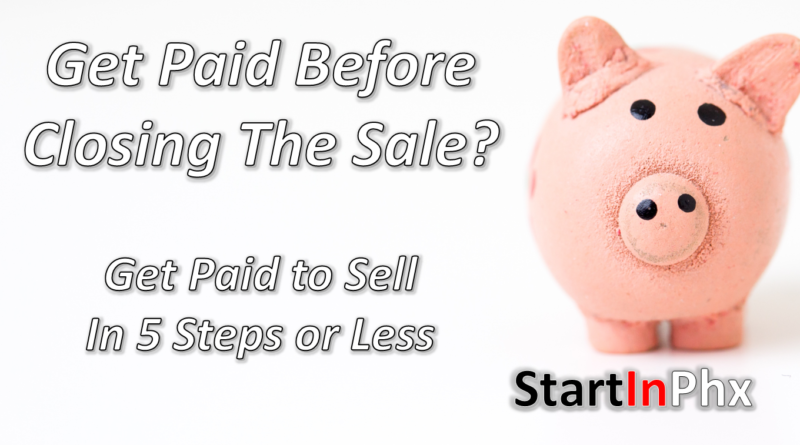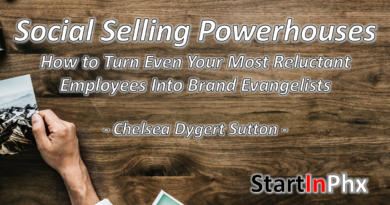Get Paid Before You Even Close The Sale
“Businesses live and die on their ability to sell!”
– Brendan Alan Barrett, Founder of StartInPhx.
5 Steps for Getting Paid to Sell
In sales there is a fine line between leading with value and getting sucked into working for free.
As a business owner or sales leader you want to be perceived as an expert in your field whose opinion is highly sought after and valued by your current and prospective clients.
And still you might be saying to yourself, “Yes – I want that for me and my company, but we still have to prove ourselves.”
But here’s the thing: Experts don’t work for free. Their consult is valuable and demands compensation.
Without getting paid when your expertise is of value and how much that expertise deserves, you diminish your ability to do the most good. You risk your company’s well-being when you get sucked into working for free.
Fees keep your company healthy. This is especially the case when a company is young and funds are tight. Only when your company is healthy can you help the people you set out to help on a meaningful scale.
Whatever your story here are five great steps to help you not only sign new clients, but get paid and stay healthy along the way.
Step #1: Believe in the process and stick to it.
Selling is a long-term game. It isn’t a one-time event. In fact, most research shows that on average, it takes a consumer seven times of seeing or hearing about your product before they will actually buy from you.
That is seven interactions – on average. It could take more.
Knowing this from the start is imperative to your success. Understanding the repetition involved and having the ability to commit to the process sets you apart from your competitors who have failed to understand this valuable step.
Hector Santiesteban of Entrepreneur Skills for Millennials, offers the profound statement, “Success is committing to the process without being emotionally tied to the results.” {View the interview}
Yes, it takes on average seven connections or touches before the consumer potentially becomes a buyer or client. Each of these touches has a purpose. You’ll learn more about that as we continue.
Start small. Keep it simple. Repeat – knowing it could take weeks, months, or even years for a prospect to become a client. Commit to the “game” and see it through to the end.
Step #2: Surround yourself with like-minded people.
Congregation isn’t reserved for church alone. Being in business can make the world a lonely place if you let it.
You believe in the process. You’re committed to it. As with any other commitment in life, it is much easier to keep this commitment when you share it with others.
Surrounding yourself with the right people matters. According to Tom Mendoza in a article for Forbes, “[The people around you] generate the opinions, humor and points of view that your mind is continuously subject to.”
In the words of Amanda Rivera, “I think there’s a part of us that knows deep down about our collective GREATNESS and when we find someone so tapped into their GODfidence (trust in the divinity of God) it reminds us ![]() . The confidence we admire in another is just a reminder of what is within ourselves.”
. The confidence we admire in another is just a reminder of what is within ourselves.”
“Life is a group project; pick your group wisely. Audit your closest peeps like your life depends on it because it sorta does,” Paloma Lev.
Surrounding yourself with great people, with other business owners, and other salespeople who also believe in the process offers a wall of understanding that encourages you through the tough times – and there will be tough times.
Remember, no one is an island. By finding an inner circle and creating deep bonds with like minded sellers you’ll gain the support you need to become even better at sales that you’d ever imagined.
Step #3: Get to know people through no-pitch intro calls.
There is more to selling than pitching. You need to create a well-oiled system for selling and no-pitch intro calls can help you to build and even reinvent is again and again as .
There’s an art and magic to the no-pitch intro call. In Brendan’s words, “It’s networking done right.” And it is.
In an interview with Landon – The Sales Gorilla – Porter inside the Getting Clients Without Being Salesy Facebook group Brendan Alan Barrett dives deeper into what the no-pitch intro call looks like and how it can be used to generate leads for your business.
No-Pitch? I thought we were suppose to be selling?
Perhaps you have something you want to bring to market, or you’re new to selling. Maybe you aren’t quite sure how your offer looks to others or you’re trying to figure out how to package it. Networking is how you figure that out.
Having conversations is the easiest way to figure out what people will buy. If you don’t know what you’re selling, talking to people can help you figure it out. You might want to try chatting with people you think might be your ideal customer in Facebook or LinkedIn’s messenger, go back and forth and few times, and set up a call to learn about each other. This is prospecting. Sales prospecting is purposeful networking. You’ll always learn something.
Things You Can Learn on a No-Pitch Intro Call
- You may learn this new prospect is your ideal client and they have money to invest. This is the best case-scenario, but it doesn’t always work out so smoothly.
- You may learn they are not your ideal client and they have no money to invest. In this case, you the conversation might help you to recognize what that looks like, and how to avoid it earlier in you sales process.
- You might learn that while the person you’re talking to isn’t a qualified prospects they are a quailified referral source: They can introduce you to a bunch of folks who are willing and qualified to buy from you. By not pitching these people – because they aren’t qualified – you avoid burning a very valuable bridge to future business.
Keep in mind that these networking calls serve as market research. Go in with the mindset of the call being nothing more that an opportunity to learn something new and you can’t go wrong.
How do you go about opening that dialogue?
This is a common question when when talking about networking and how it works for a salesperson.
- Speak to people. We’re all human. It isn’t necessary to pitch your sale to everyone you meet. In fact, often that isn’t how you should begin at all. Make connections daily whether in person, online, or even through messenger. Just say hello.
- Ask questions – even if you already know the answers. Allow them to talk about themselves. Make it about them.
- Compliment them. Praise their efforts, their work, their vision. Make being with you something they enjoy – they will want to keep you around longer. You become more interesting to them because you are interested in them.
- They will most often want to reciprocate by asking about you. This opens the door for you to share your products and services without being “salesy” (something we all detest equally).You shouldn’t us this as an oppotunity to lean in with a heavy pitch. You don’t need to. Your prospect is now asking questions and getting to know you. Let them set the pace and frame the conversation with their own curiosities.
As you learn to perfect the no-pitch intro call, you’ll figure out what stories to share with new contacts. But even if at first some of the narratives you share in your first few intro call don’t relate specifically to the person you’re speaking with, it may get them to think of a friend who has a problem you can solve.
When you enter conversation with a mindset of learning there will always more ways to walk away with a win – something you can use to nudge you closer to you goal – than there are ways for the exchange to end with you having lost. You can’t lose.
Step #4: Win Permission to Sell
You’ve asked the questions and given the prospect the opportunity to share more about themselves.
You’ve developed a system for getting to know your prospects before pitching to them. By now, you have developed a sense of rapport and you have had several communication ‘touches’ that have continued the line of questioning.
Because you have been interested in them, they are now interested in you.
Permission-based selling is as simple as asking, “What do you want to do next?” If they are in fact qualified they may even respond with something along the lines of, “Well, how much would if cost for you to do _____ for me?”
That’s what being granted permission to sell sounds like!
Of course, if they don’t ask you the ‘How much?’ question but everything about your conversation to this point has the little voice in your head screaming, “We 100% would knock it out of the park for this person!” all you have to do is make the suggestion.
Similar to the way waiters always ask if you want to see a desert menu, all you have to do is ask. You don’t get mad when a waiter suggests desert, do you?
Of course not.
By asking a simple question, you gain permission to move forward or the insight to move on. Just like you when you’re out to dinner they can say ‘No’ and end the discussion or ‘Yes’ and open the door for continued conversation.
So if after hearing about someone’s world and all about the things they like, love, hate, and want for the future you’ve reached a point where the little voice in your head is screaming, “We 100% would knock it out of the park for this person!” try asking something like:
From what you’ve described it sounds like Insert The Thing You Sell would help you accomplish The Result They Want . Would you be interested in hearing what that would look like if I were to help you make that happen?
Super simple, right?
Step #5: Prequalify Your Prospects Like a Pro and Getting Paid to Pitch
So after connecting a few times and determining that the prospect actually has the potential to become a paying client. You’ve asked or won their permission to sell.
If you’re a web designer and/or digital marketer for example, your next step probably looks like an audit of the prospective customer’s current site. Only once that audit has been performed would you be equipped to develop a strategy and then quote services in line with executing that strategy.
THAT’S A SERVICE!
DON’T DO IT FOR FREE!
If you’ve been networking for some time. You’ve already had a chance to build rapport, enough so that they are interested in learning more.
Charge for the evaluation or audit. The simple act of requiring payment thins your field of prospects so that you can focus on serving the most qualified. The tire-kickers, the prospects who will never buy from you, will disqualify themselves from continuing down the buyers journey and consuming time that could be better spent with prospects who would love to pay you for the value you bring to the world.
The deliverable of your audit or consultation will look like a prescription for next steps. Prioritize those steps and itemize the costs for the various stages of that prioritization. From your dialog with the prospect and the audit you’ll know exactly what they really need or want. You’ll also know exactly what version of your offer will be required to accomplish what they want.
What if the price is too high?
Using your list of priorities and itemized price list the prospect can tell you what they can afford to do and what they must wait to act on.
Either way you get paid to solve a portion of their problem (if not the entire thing) without being pressured to sell things they don’t need. That’s right. If you learn through your audit that the products or services you sell can’t deliver the result the prospect is after you can simply decide to part as friends.
To often sellers feel pressured to sell their prospects on offerings simply to recoup the labor expended to audit the need. That’s a terrible place to find yourself. Getting paid to sell helps to fix that problem.
In the event your work together ends after a paid audit or consultation, you’re healthy enough to pursue other sales and the prospect gained the perspective of what they shouldn’t buy, why that’s the case, and at a significantly lower cost than paying for a failed project, campaign, etc.
In this world your best marketing is your service.
When a prospect hires you and you deliver on your promise they feel good about paying you again and/or referring you to their colleagues.
In the time it takes for you perform a paid audit and deliver your recommendations you also gain the opportunity to build a higher level of rapport. From that level of rapport higher priced offers (i.e. the recommendations that come from your paid audit) become much easier to sell.
How to Get Paid to Pitch
As a Digital Marketer at Minute 31:30
If the prospect is unwilling or unable to pay for the initial evaluation, they are not your ideal client.
What about prospects who won’t pay for the evaluation?
If the prospect is unwilling or unable to pay for the initial evaluation, they are not your ideal client. Prequalifying buyers better enables you to prioritize your time and efforts for the right clients.
Selling isn’t for the faint of heart. It takes effort and commitment.
Believing in the process and committing to it, surrounding yourself with like-minded people, networking, winning permission to sell, and prequalifying your buyer are all carefully designed steps to the dance of selling.
“Businesses live and die on their ability to sell.” Develop your skill or that of your sales team. Practice until you’re a well-oiled sales machine. Then use it to build a thriving business.
About The Author of This Article: Kalynn Dier is the founder of SHE Co Gladiator. “Find your passion, love your life.” Kalynn left a 26-year medical career to get a degree in marketing and pursue her three passions:
· Being a full-time stay-at-home mom
· Helping women find their passion and love their life
· Bring awareness to the epidemic of Sex Trafficking in the US.
Instead of fighting fires and saving lives, Kalynn now spends her days homeschooling her 5-yr old daughter and mentoring female entrepreneurs as they navigate their journey in the business word.
Learn More at SHECoGladiator.com
Struggling to Drive Sales in Your Business?
DOUBLE MY REVENUE
7-Day Sales Challenge
Whether you’re a sales professional or entrepreneur who needs to level up their sales skills, this free 7-day challenge will teach you how to better identify and prioritize prospects you can covert into customers quickly. It will also teach you proven systems for year-over-year sales growth.
Click HERE to learn more about this FREE 7-day sales challenge.
OR — You can click HERE to book a FREE 1-on-1 strategy call with me!




